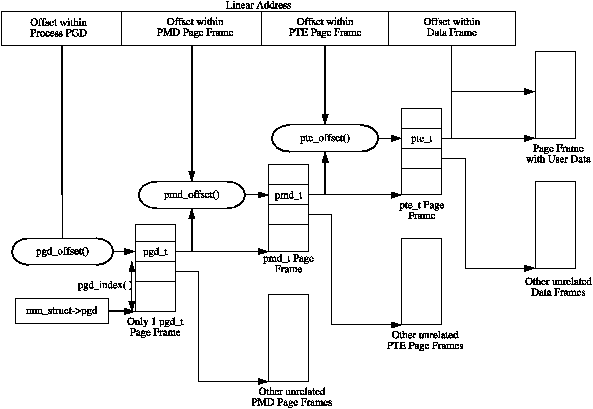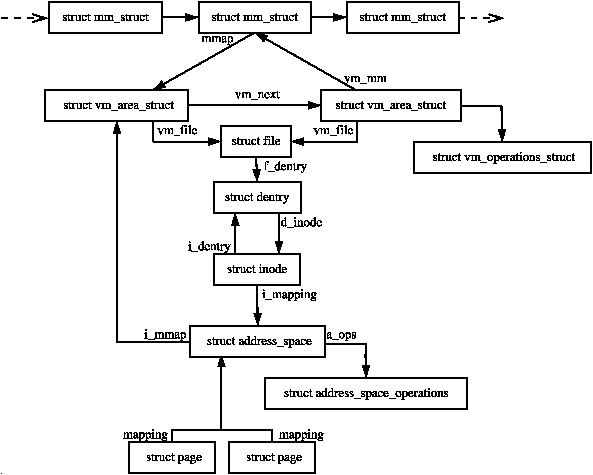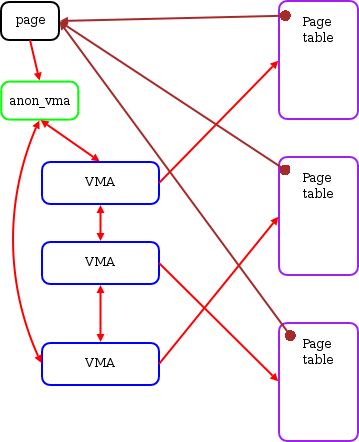2021q1 Homework3 (quiz3)
contributed by < linD026 >
tags: linux2021
0 進度
- 1 解釋程式碼運作原理與改進
- NULL
- 2 提供字串複製 ( CoW ) 實作
- NULL
- 3 實驗 - 字串空間效率最佳化
- NULL
- 4 整合 - 字串空間最佳化
- 多執行緒下的保證
- 5 Linux 核心 內部實例
- mm_struct, address_space, page 之間的關係要在釐清
- CoW 在 page 的實作
- 各步驟說明要完善
1 解釋程式碼運作原理與改進
結構定義
- 小字串: 字串長度不超過 15 , 儲存於 stack 。
- 長度為 15 減去以 4 個 bit 方式儲存的
space_left表示。 - 字串儲存於 15 位元組的
filler字元陣列中。
- 長度為 15 減去以 4 個 bit 方式儲存的
- 中字串: 字串長度介於 16 至
LARGE_STRING_LEN(此為 256 ), 儲存於 heap。- 使用
data指標提取字串。 - 長度以
size表示。最大長度以被分配的 bit 多寡決定。此為 54 bits 共 最大長度。 - 分配的空間大小以
capacity表示。應須涵蓋到size所能表示的範圍,因此以二的次方來儲存。在此 6 bits 來表示,共 。 - 在最後 4 個 bit 中儲存了判斷是否為指標(是否為小字串)、大字串等,各為 1 bit 的標示。
is_ptr、is_large_string、flag2、flag3
- 使用
- 大字串: 字串長度超過
LARGE_STRING_LEN,儲存於 heap。- 使用 CoW 作最佳化。
- 基本資訊與中字串一致。
- 但在提取字串的指標上和中字串不同,其在原先指標的前 4 個 byte 的位置儲存了
int型態的refcnt(reference count),因此在存取字串時須注意。
- 取得資訊的函式
- 下列函式皆為提取該字串的資訊。
- 可以看到
xs_capacity在提取時是以 2 的冪 (利用對1作位元偏移)。
- refcnt - 大字串的 CoW
- ilog2
- 利用
__builtin_clz取得該數的the number of leading 0-bits並減去 32 (視型態此為uint32_t) 取得該數的左邊算起來第一個 1 的位數後減 1 。 - 例子:
等於
等於
- 利用
- xs_allocate_data
- 依照字串的資訊分配適當的記憶體,利用
bool reallocate來判斷是擴充還是分配新的記憶體空間。 - 如果
len符合大字串,則可以看到在分配時跳過了前四個 byte 。
- 依照字串的資訊分配適當的記憶體,利用
- xs_new
const void *p為要儲存的字串。- 記憶體分配可以分成在 stack 或 heap 兩種,中字串與大字串的區隔則在
xs_allocate_data裡決定。
- xs_tmp
_Static_assert是 C11 新增的檢測方式,在編譯時期檢測錯誤。The constant expression is evaluated at compile time and compared to zero. If it compares equal to zero, a compile-time error occurs and the compiler must display message (if provided) as part of the error message (except that characters not in basic source character set aren't required to be displayed).
Otherwise, if expression does not equal zero, nothing happens; no code is emitted.
//TODO 為什麼是這寫法 ((void) (struct{_Static_assert(); int dummy;}){1}), function())
- xs_cow_lazy_copy
- 此函式以名稱來看是在 CoW 時的複製。
- 一般來說, lazy copy 是指當 B 物件複製 A 物件的資料時,B 物件所擁有的資料是直接指向 A 原資料。當作更改時,再獨立複製出來。
- 此
char **data為要複製的資料,複製至xs *x並讓data指向複製的內容。
- 例子:
- pointer 指向資料來源 A 所擁有的資料
- 配置記憶體給 B 作存放複製的資料
- 把 pointer 指向的資料複製進 B
- 複製完後,讓 pointer 重新指向複製的資料。
- 但這沒有滿足所要的 lazy copy ,亦即複製時是 shadow copy。
- 此函式的作用只有分配記憶體並複製以即使
char **data所擁有的指標指向複製的資料而已。 - 因此可以改成不以字串獨立出
xs結構作操作,而是直接以原始資料與複製目的地作操作。 - 而且原始資料的 reference count 在複製時也增加,以紀錄有多少物件共通使用此資料。
- 在這裡我也
xs結構所沒使用到的flag2改成sharing,紀錄複製物件所使用的資料不是自己的。 - 而
flag3則是改成source來紀錄來源物件的資料是有被其他物件使用到。
- xs_concat
- 此函式在字串串接,以目標物件目前所擁有的記憶體大小作區分。
- 若是最後大小小於等於
capacity直接複製,再判斷是否是大字串還是小字串來作字串長度的處理。 - 若是大於則重新分配。
xs_cow_lazy_copy是多餘的。
- xs_trim
- 此函式最主要的地方是在如何紀錄要消除的字元以及如何檢測。
- 在此,是以字元本身的 bit 數來判斷。
- 例如紀錄字元
A( or ) : - set_bit: mask[65/8] = mask[65/8] | 1 << 65 % 8
- set_bit: mask[0100 0001 >> 3] = 0000 0000 | 0000 0001 << (0100 0001 & 0000 0111)
- set_bit: mask[8] = 0000 0010
- 接下來在 檢測時 (check_bit) 逆向執行此操作來看有沒有符合:
- 例子
A( or ) : - check_bit: mask[8] = 0000 0010
- !(0000 0010 & 0000 0001 << 1) 為否( !(true) ),跳過此字元。
- 例子
B( or ) : - !(0000 0010 & 0000 0001 << 2) 為是( !(false) ),中止。
- 最後頭尾都做一遍,便達到此目的。
- 關於記憶體操作則是設
orig紀錄原先指標的位置。 - 再利用
dataptr和slen指向剩下所需的字串與其長度。 - 最後,把剩下所需的字串位移到
orig即完成。
- 此函式可以在
byte / 8和byte % 8時改進成byte >> 3和byte & 7。 - 且
xs_cow_lazy_copy是多餘的。
Reference
2 提供字串複製 (CoW) 實作
我針對 copy on write 設定兩個參數其一為 sharing 表示字串是不是共通的亦即別人的,另一個是 source 表示是否為來源字串。
在對字串進行操作時若是 CoW 則使用 xs_cow_write_trim 和 xs_cow_write_concat 兩個 marco 來處理。
缺點是對複製字串進行操作時須知道他的來源字串為何,才可對來源作 xs_dec_refcnt 等操作。
Reference
3 實驗 : 字串空間效率最佳化
完整程式碼。
實驗一 : 記憶體空間
- 設字串長度為 261,分別比較
malloc和xs_new後在進行複製的差異。 malloc以在建議一個指標malloc後再memcpy,xs的複製以xs_cow_copy為主。- 可以看到兩者不是差很多,都介於 512 大小。
- malloc 還可以理解,但 xs 結構卻也是 512 這就有點驚訝了。
- 後來仔細檢查後發現,在
xs_new裡的記憶體配置是以 2 的冪來估算 (capacity)。因此 是不夠,會以 來分配。 - 這優點在於當要使用更多記憶體可以不用再
realloc,缺點是不需要多的記憶體每次還是會給你多一倍的空間,導致會有相等大小的記憶體沒被使用到。 - 根據老師所說
因此還需要設計 reclaim
- 設計了能夠調整記憶體大小的函式。並且把目前可以以
reference count取代的source改成reclaim。 - 當
xs *x的字串儲存結構為指標且不是CoW的shadow copy則可以進行調整成適當大小的空間。 - 在測試時,發現調整過的大字串的記憶體大小確實縮小成符合自身的
264,但多餘的記憶體272並沒有馬上被釋放,而是先放在extra-heap之中。 - 之後修改函式讓其調整回原先記憶體大小,可以看到當有需要的時候會直接從中 (
extra-heap) 拿取。
實驗二 : 小字串 的 locality of reference
- 測試小字串儲存在
stack(opt_store) 和heap(normal_store) 之中,所呈現的效能差異。 - 為了模擬字串操作對記憶體的使用,在測試時
stack和heap都會進行以下操作: - 關於各字串內容:
- 第一次測試時,只有對小字串作一次存取兩者差異不會很大。
- 初步猜測是因為記憶體使用率不高,
stack和heap的字串都可以直接儲存在cache裡。 - 如果細部檢測
L1是可以明顯到看兩著並無太大落差: - 後來改了小字串的儲存結構,從單一字串變為
NUM大小的字串陣列,分別是:
char *small[NUM] = {0};和xs small[NUM]; - 而在
print出小字串的步驟,則選擇陣列的NUM/2小字串。 - 會這樣做是因為要讓記憶體使用率提昇,讓儲存在
stack和heap所擁有的特徵提高。 - 更改過後,可以看到
L1確實有差異性了: - 只是更改儲存位置卻可以明顯看出在
cache-misses,cache-references,instructions、cycles,ref-cycles,存放於stack的實作都比在heap好。 - 關於此差距,從 locality of reference 的
Spatial locality可以看出,在使用儲存位置較相近資料時有較好的表現。
延伸探討
以下若非特別聲明皆引自 stackoverflow - Is accessing data in the heap faster than from the stack?
stack
Allocation and deallocation
- 編譯時期編譯器已把資料和函式一併建構。
For stack-based data, the stack-pointer-register-relative address can also be calculated and hardcoded at compile time. Then the stack-pointer-register may be adjusted by the total size of function arguments, local variables, return addresses and saved CPU registers as the function is entered and returns (i.e. at runtime). Adding more stack-based variables will just change the total size used to adjust the stack-pointer-register, rather than having an increasingly detrimental effect.
Layout and Access
- 連續記憶體配置。
Because the absolute virtual address, or a segment- or stack-pointer-register-relative address can be calculated at compile time for global and stack based data, runtime access is very fast.
If successive lines of your source code list global variables, they'll be arranged in adjacent memory locations (albeit with possible padding for alignment purposes). The same is true for stack-based variables listed in the same function.
- 各執行緒可以有自己的
stack(跟執行的函式有關),亦即儲存於自己的stack的資料只有自己可以讀取。
heap
Allocation and deallocation
- 執行時期才配置。
- 在資料儲存時如果當下 heap memory 分配不夠,會需要系統呼叫如 sbrk mmap 等巷系統要求更多記憶體。
- 儲存於 heap 的資料並不保證每個位置都會是連續的,這取決於作業系統的實作,也因此在存取時的花費會高於 stack 。
For heap-based data, a runtime heap allocation library must consult and update its internal data structures to track which parts of the block(s) aka pool(s) of heap memory it manages are associated with specific pointers the library has provided to the application, until the application frees or deletes the memory. If there is insufficient virtual address space for heap memory, it may need to call an OS function like
sbrkto request more memory (Linux may also callmmapto create backing memory for large memory requests, then unmap that memory onfree/delete).
Layout and Access
- 讀取資料時,指標以及資料本身都要在 cache 裡,且兩者通常會是不連續位置。
- 不連續記憶體以及間接存取皆會使 cache misses 上升。
For the heap access, both the pointer and the heap memory must be in registers for the data to be accessible (so there's more demand on CPU caches, and at scale - more cache misses/faulting overheads).
With heap hosted data, the program has to access the data via a runtime-determined pointer holding the virtual memory address on the heap, sometimes with an offset from the pointer to a specific data member applied at runtime. That may take a little longer on some architectures.
- 多執行緒下,儲存於 heap 的資料各執行緒都可以看到。
總結
資料存放於 stack 和 heap 的成本在配置記憶體、存取與儲存形式都有很大的落差。
其中,維護儲存於不連續記憶體( heap )的成本,確實高於 stack 。
關於相關詳細比較,那篇 stackoverflow 的下方也有人提及兩者效能表現比較的文章:
Reference
- wikipedia - Locality of reference : Spatial and temporal locality usage
- stackoverflow - How does Linux perf calculate the cache-references and cache-misses events
- brendangregg.com - perf examples
- easyperf.net - Performance analysis vocabulary.
- pcsuggest.com - 4 ways to disable NMI watchdog in Linux
- HackMD - perf 原理和實務
- geeksforgeeks.org - Stack vs Heap Memory Allocation
- stackoverflow - Is accessing data in the heap faster than from the stack?
- publicwork.wordpress.com - Stack allocation vs heap allocation – performance benchmark
- stackoverflow - Dynamic allocation store data in random location in the heap?
- medium.com - Understanding Memory Layout
- www.cs.princeton.edu - Memory Management - Jennifer Rexford
4 整合 - 字串空間最佳化
整合第二周的 string interning 和第三周的xs 。
hash table管理的節點結構更改:- 小字串直接建立。但當使用長度達到中字串以及大字串時,放入至
hash table裡控管。 cstr_interning會回傳hash table中紀錄的節點所擁有的xs。xs_new則是將其複製。- 此函式的功能不再只是建立字串,而是在中字串以及大字串的範圍下建立
hash table的資料。
- 此函式的功能不再只是建立字串,而是在中字串以及大字串的範圍下建立
- 在
interning,新建的節點操作是建立後,再對記憶體reclaim成適當大小。 - 當然也可以直接分配適當大小的記憶體,在此我先活用現有的函式。
- 關於字串操作,中字串以及大字串所有的資訊除了字串本身是指向
hash table的資料,其他都是副本,因此在操作的前置動作只須對指標以及原先資料的reference count作處理就行。 - 操作結束後,透過
xs_new來建立hash table裡資料,原先物件則釋放掉。- 最後是包裝成
marco:
- 最後是包裝成
- 需注意幾點
hash table的資料不會被刪除。- 讀取
hash table資料:- 如果是要副本須透過
xs_new。 - 如果是
hash table裡的原始資料則為cstr_interning。
- 如果是要副本須透過
- 中大字串一定要藉由包裝過的 marco 如
xs_cow_write_trim來操作。 - 並沒有限制
xs_trim等直接操作,因此小字串直接操作即可。 - 小字串在
xs_concat成長為中大字串時,會自動寫入hash table,並且使用者拿到的xs會是副本。 - 如果
xs的物件利用xs_grow擴大記憶體,則物件不會紀錄至hash table。
- 最後,我也保留了原先 CoW 操作的函式:
- 因此
xs_tmp可以改成xs_new_self的建立,如果想要自己釋放掉且不想被儲存的話。
完整程式碼: linD026
5 Linux 核心 內部實例
fork
- 實作手法為 copy on write 。
DESCRIPTION
fork() creates a new process by duplicating the calling process. The new process is referred to as the child process. The calling process is referred to as the parent process.The child process and the parent process run in separate memory spaces. At the time of fork() both memory spaces have the same content. Memory writes, file mappings (mmap(2)), and unmappings (munmap(2)) performed by one of the processes do not affect the other.
- 有趣的是 fork 的 CoW 操作需要 MMU 的幫助。因此在如 uclinux 等架構下,沒辦法使用 fork 而是需要 vfork 來操作。
- 在下方引述資料可以看到,因為 vfork 的實作, child 對記憶體的改變也會在 parent 顯現。
With vfork(), the parent process is suspended, and the child process uses the address space of the parent. Beacuse vfork() does not use copy-on-write, if the child process changes any pages of the parent's address space, the altered pages will be visible to the parent once it resumes.
引自:Operating System Concepts 10th Edition Asia Edition - page 400Historic description
Under Linux, fork(2) is implemented using copy-on-write pages, so the only penalty incurred by fork(2) is the time and memory required to duplicate the parent's page tables, and to create a unique task structure for the child. However, in the bad old days a fork(2) would require making a complete copy of the caller's data space, often needlessly, since usually immediately afterward an exec(3) is done. Thus, for greater efficiency, BSD introduced the vfork() system call, which did not fully copy the address space of the parent process, but borrowed the parent's memory and thread of control until a call to execve(2) or an exit occurred. The parent process was suspended while the child was using its resources. The use of vfork() was tricky: for example, not modifying data in the parent process depended on knowing which variables were held in a register.
引自: Linux Programmer's Manual - vfork()
Reference
- 成大資工wiki - uclinux
- cs.unc.edu - CSE 306: Lab 2: Copy-on-Write Fork
- Operating System Concepts 10th Edition Asia Edition - page 400
相關閱讀
page
一個 process 對一塊 page 讀取時,根據不同硬體架構會有特定的 page table 來讀取。
Each process a pointer (mm_struct→pgd) to its own Page Global Directory (PGD) which is a physical page frame. This frame contains an array of type pgd_t which is an architecture specific type defined in <asm/page.h>. The page tables are loaded differently depending on the architecture. On the x86, the process page table is loaded by copying mm_struct→pgd into the cr3 register which has the side effect of flushing the TLB. In fact this is how the function __flush_tlb() is implemented in the architecture dependent code.
kernel.org - Chapter 3 Page Table Management
而當多個 process 共用一個 page frame 時,則會採用 CoW :
Operating system support in distributed system此投影片主要講 threads in distributed system
硬體架構
- linux kernel source tree - root/arch/x86/include/asm/page.h
- linux kernel source tree - root/include/asm-generic/page.h
- 在
generic page.h的註解可以看到,這用於NOMMU architectures。
- 在
實作層級
- linux kernel source tree - root/include/linux/pgtable.h
- linux kernel source tree - root/include/linux/pagemap.h
- linux kernel source tree - root/arch/x86/include/asm/io.h
- linux kernel source tree - root/mm/filemap.c
sharing page table
mm_struct
- 每個 user-address-space 都有一個。
- 記錄所有記憶體相關資訊,不管是本身記錄或是間接紀錄( pointer )。
vm_area_struct / vmas
- 每個相同檔案的 backing, permissions, and sharing characteristics 的記憶體區塊都有一個。
- 必要時可做分離與合併。
- 與 mm_struct 連結,且有排序:
There is a single chain of vmas attached to the mm_struct that describes the entire address space, sorted by address. This chain also can be collected into a tree for faster lookup.
- 紀錄:
- same characteristics
- starting and ending virtual addresses of the range
- file and offset into it if it is file-backed
- set of flags
- shared or private
- writeable
- same characteristics
The page table
- 分三個層級:
- the page directory ( pgd )
- the page middle directory ( pmd )
- the page table entries ( pte )
- Each level is an array of entries contained within a single physical page
address_space
address_space structure is the anchor for all mappings related to the file object. It contains links to every vma mapping this file, as well as links to every physical page containing data from the file.
The only vmas not attached to an address_space are the ones describing the stack and the ones describing the bss space for the application and each shared library. These are called the ’anonymous’ vmas and are backed directly by swap space.
page
All physical pages in the system have a structure that contains all the metadata associated with the page.
mapping
mmap分配一段記憶體空間,此空間以新的或是改寫過的 vma 表示,跟 task 的mm_struct和address_space相連。mmap呼叫時 The page table 並沒有操作。
lock
-
有三個 lock
a read/write semaphore-mm_structpage_table_lock-mm_structi_shared_lock(i_shared_sem) -address_space
-
sharing PTE Page
- page_table_lock 沒辦法完全保護
- pte_chains (在 2004 被移除)
- pte_page_lock 保護
- 也就是說, page_table_lock 只保護到找到想要的 pte page ,之後由 pte_page_lock 保護。
然而上述資料有點舊,跟現況不太符合。
關於 pte_chain 的演進:
因此,又找了這份投影片來解析 struct page 在 CoW 下得操作:
vma
vma 的整體結構圖
vma 資料搜尋
page
struct page簡述
anon_vma管理 CoW 的 page
anon_vmain action
anon_vmain action
kernel.org - mm Concepts overview
The anonymous memory or anonymous mappings represent memory that is not backed by a filesystem. Such mappings are implicitly created for program’s stack and heap or by explicit calls to mmap(2) system call.
Usually, the anonymous mappings only define virtual memory areas that the program is allowed to access. The read accesses will result in creation of a page table entry that references a special physical page filled with zeroes. When the program performs a write, a regular physical page will be allocated to hold the written data. The page will be marked dirty and if the kernel decides to repurpose it, the dirty page will be swapped out.
page 在 CoW 的操作。
kernel.org - Chapter 4 Process Address Space
- bootlin.com - /mm/memory.c - do_wp_page
- 以假設有保護的情況下,進行 CoW
- mark dirty bit
- 要進行 CoW 的
old_page會先處理 anonymous pages 狀態 - 複製過後的資料會被移入至
anon_vma,以確保在尋找資料時不會找到 parent 或 siblings - 如果不是 anonymous page 則會:
總結
- 一個
mm_struct結構控管多個vm_area_struct, 而其中vm_area_struct又以資料結構來儲存。(rbtree)。 vm_area_struct的 mapping 可以是 Anonymous mapping 。- Anonymous mapping 包含了 CoW pages 。
vm_area_struct再藉由多個資料結構如struct inode struct,address_space mapping(priorty tree -i_mmap, radix tree -page_tree) 等至 struct page 。- 而
pages的儲存結構為 radix tree 保存於address_space。(如果要直接對 page 操作的話,方便反向尋找) - 之後藉由
do_cp_page等函式,搭配 lock 去做 CoW 處理。 (/mm/memory.c) - 操作完後,有一個分支是執行
establish_pte,建立 page table entry 來提升效率。註:現今實作又改了:
- xarray ( replace radix tree )
- lwn.net - The Xarray data structure
The kernel's radix tree is, he said, a great data structure, but it has far fewer users than one might expect. Instead, various kernel subsystems have implemented their own data structures to solve the same problems. He tried to fix that by converting some of those subsystems and found that the task was quite a bit harder than it should be. The problem, he concluded, is that the API for radix trees is bad; it doesn't fit the actual use cases in the kernel.
- radix tree 的概念沒有變,但從 tree 改成 array (an automatically resizing array)
unsigned long的 array of pointer
- 更改的原因是因為儲存結構以及相關操作的函式太過模糊。
Part of the issue is that the "tree" terminology is confusing in this case. A radix tree isn't really like the classic trees that one finds in data-structure texts. Addition of an item to a tree has been called "insertion" for decades, for example, but an "insert" doesn't really describe what happens with a radix tree, especially if an item with the given key is already present there. Radix trees also support concepts like "exception entries" that users find scary just because of the naming that was used.
- lwn.net - The Xarray data structure
延伸閱讀
最後,實作一直在改進,周遭資訊卻很難跟上。 (譬如 struct address_space 中看起來取代 radix tree 的 xarray 沒多少資訊)
光是要找到正確的資訊就好困難。
雖然可以從現今程式碼著手,但在沒整體架構的演進與變化脈絡的知識,真的會看不太懂。
Reference
- Operating system support in distributed system
- kernel.org - Chapter 3 Page Table Management
- kernel.org - Chapter 4 Process Address Space
- lwn.net - kernel development - Fixing up the shared page table patch
- 從 radix tree 到 xarray
- lwn.net - rmap 9 remove pte_chains
- cs.columbia.edu - W4118: Linux memory management
- 匿名反向映射的前世今生
- static.lwn.net Kernel development - January 24, 2002
- The Priority Search Tree
- lwn.net - A multi-order radix tree
- Page Cache
- lwn.net - Maintainer activity per subsystem
- lwn.net - Fixing up the shared page table patch
- Sharing Page Tables in the Linux Kernel - Dave McCracken IBM Linux Technology Center Austin, TX - 2003
- lwn.net - Virtual Memory II: the return of objrmap
- stackoverflow - What are memory mapped page and anonymous page?
相關閱讀 (有訂閱 lwn.net 可以看)
- Patching until the COWs come home (part 1)
([Kernel] Posted Mar 22, 2021 16:52 UTC (Mon) by corbet)
The kernel's memory-management subsystem is built upon many concepts, one of which is called "copy on write", or "COW". The idea behind COW is conceptually simple, but its details are tricky and its past is troublesome. Any change to its implementation can have unexpected consequences and cause subt […] - Patching until the COWs come home (part 2)
([Kernel] Posted Mar 25, 2021 16:30 UTC (Thu) by corbet)
Part 1 of this series described the copy-on-write (COW) mechanism used to avoid unnecessary copying of pages in memory, then went into the details of a bug in that mechanism that could result in the disclosure of sensitive data. A patch written by Linus Torvalds and merged for the 5.8 kernel appear […]
btrfs
// TODO



















